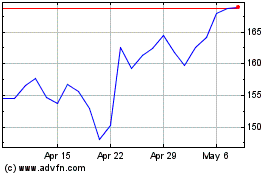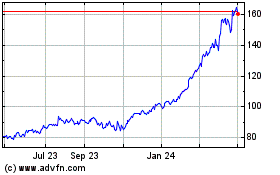Hyperloop One Accelerates Toward Future
May 11 2016 - 3:10PM
Dow Jones News
LAS VEGAS—Hyperloop technology this week is accelerating toward
becoming a reality.
On Wednesday in the desert north of Las Vegas, Hyperloop One
Inc. was planning the first test of the propulsion system that is
essential to the high-speed transportation invention.
On the eve of the test, the company announced it has formed ties
with more traditional transportation companies and raised fresh
capital.
All are milestones in the company's plan to create a fully
operational hyperloop system by 2020.
"The hyperloop is real. It's happening now," said Chief
Executive Rob Lloyd, during an interview in Las Vegas. The company
on Tuesday changed its name from Hyperloop Technologies, to help
distinguish it from its main rival.
Hyperloop One is one of the startups aiming to commercialize the
idea that billionaire inventor Elon Musk floated in a 2013 paper:
transporting people in low-pressure tubes at 760 miles an hour,
nearly the speed of sound. Mr. Musk envisioned it as pods powered
by propulsion motors that use magnets to hover on a sliver of air
in near-vacuum tubes. The lack of air resistance and friction of
traditional transportation are what would allow it to achieve such
high speeds.
Hyperloop One is jockeying with Hyperloop Transportation
Technologies Inc. to be the first to bring Mr. Musk's idea to life.
On Monday, Hyperloop Transportation said it created a way to
elevate hyperloop pods using permanent magnets, a new technique
that is cheaper and conserves more energy than previous methods. It
hasn't yet demonstrated its propulsion technology. Hyperloop One
said it also is experimenting with permanent magnets.
The hyperloop idea has faced significant skepticism, pertaining
more to its cost than its technology. Mr. Musk has said that a San
Francisco-to-Los Angeles hyperloop would cost $6 billion. Experts
expect it could be much more expensive.
"We will reduce the cost of the hyperloop until it is two-thirds
the cost of a high-speed rail system at three times the speed," Mr.
Lloyd said.
Established in 2014, Hyperloop One raised an initial $37 million
in funding and set up an office in Los Angeles. Last December, the
company started building its test site north of Las Vegas,
including a half-mile-long open-air track that was to be used
Wednesday.
To reduce costs, the company is breaking down its design into
different parts such as levitation, propulsion and tube design, and
then learning to build each with less expensive materials.
The propulsion mechanism that Hyperloop One was due to test
Wednesday is the first segment of the project. If all goes
according to plan, a roughly 10-foot sled containing the propulsion
motor will zip forward on tracks, for about two seconds, at 116
miles an hour. It should crash into a pile of sand because the
company hasn't yet built brakes for the contraption. The sled won't
carry any passengers.
The focus of the test will be more on the propulsion
technology—whether it can actually move the sled—than the speed.
The track is shorter and there will be air resistance, two slowing
factors which will be eliminated in future tests.
Hyperloop One also is trying to prove that its technology will
be worth deploying. The company said Tuesday that it is
participating in private-feasibility studies to examine a potential
hyperloop route between Stockholm and Helsinki, as well as networks
to transport cargo from the ports of Los Angeles and Long Beach,
Calif., and throughout Switzerland.
In March, Hyperloop Transportation Technologies signed an
agreement with the Slovak government to explore building a
hyperloop in the European country.
Hyperloop One's latest funding comes from new investors that
have transportation expertise. The $80 million Series B financing
investors include France's national rail company, SNCF, and GE
Ventures, the venture arm of General Electric Co., whose
transportation unit makes locomotives.
By the end of this year, Hyperloop One plans to build and test a
complete hyperloop, including the tube, pod and the computer that
pilots the pod, Mr. Lloyd said. That pod should travel about 700
miles an hour, he said. "We think we will be able to demonstrate
full Kitty Hawk capabilities by the end of this year," Mr. Lloyd
added.
Write to Georgia Wells at Georgia.Wells@wsj.com
(END) Dow Jones Newswires
May 11, 2016 14:55 ET (18:55 GMT)
Copyright (c) 2016 Dow Jones & Company, Inc.
GE Aerospace (NYSE:GE)
Historical Stock Chart
From Mar 2024 to Apr 2024

GE Aerospace (NYSE:GE)
Historical Stock Chart
From Apr 2023 to Apr 2024
